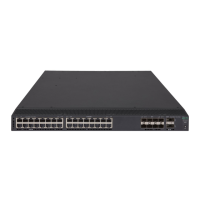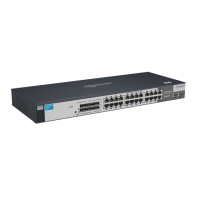37
In a stable fabric, the configured priority does not take effect immediately. Therefore, the runtime priority
of a switch might be different from the configured priority. To make the configured priority take effect, use
the domain restart disruptive command to perform a disruptive reconfiguration. After a disruptive
reconfiguration, the runtime priority could still be different from the configured priority, depending on the
configured priority value, as shown in Table 3.
Table 3 Configured priority and run
time priority mappings
Confi
ured
riorit
Runnin
riorit
≤ 2
• Principal switch—Same as the configured priority.
• Non-principal switch—3.
> 2
• Principal switch—2.
• Non-principal switch—Same as the configured priority.
To set the switch priority:
Ste
Command
Remarks
1. Enter system view.
system-view N/A
2. Enter VSAN view.
vsan vsan-id N/A
3. Set the switch priority in the
VSAN.
priority value The default setting is 128.
Configuring an allowed domain ID list
To successfully configure an allowed domain ID list on the principal switch, make sure all assigned and
locally configured domain IDs are included in the list. After you configure an allowed domain ID list, the
principal switch assigns only domain IDs available in the allowed list.
To successfully configure an allowed domain ID list on a non-principal switch, make sure the runtime
domain ID of the switch is included in the allowed list. After you configure an allowed domain ID list on
a non-principal switch, the following rules apply:
• The locally configured domain ID must be included in the allowed list. Otherwise, the domain ID
configuration fails.
• The principal switch must assign a domain ID that is included in the allowed list of the non-principal
switch. Otherwise, the non-principal switch refuses the assigned domain ID and isolates its interface
connected to the principal switch.
HP recommends that you configure the same allowed domain ID list for all switches in a VSAN.
To configure an allowed domain ID list:
Ste
Command
Remarks
4. Enter system view.
system-view N/A
5. Enter VSAN view.
vsan vsan-id N/A
6. Configure an allowed domain
ID list for the VSAN.
allowed-domain-id
domain-id-list
By default, the allowed domain IDs are 1
to 239.
